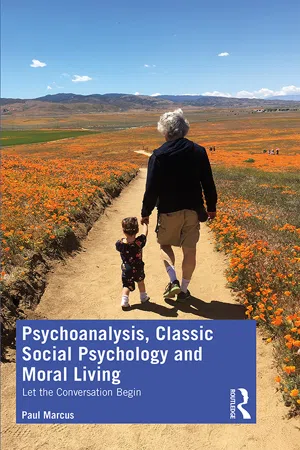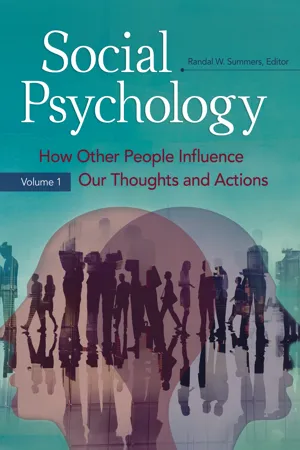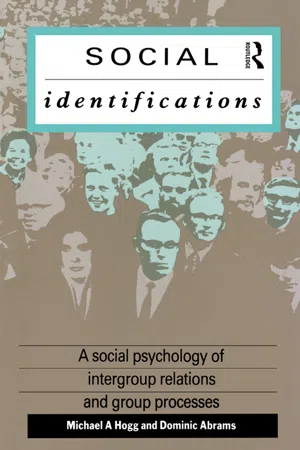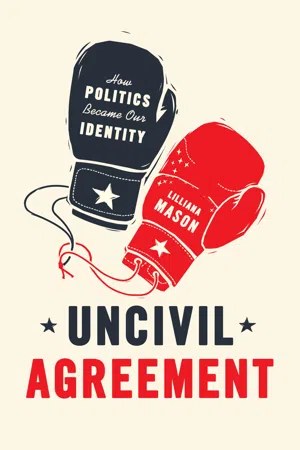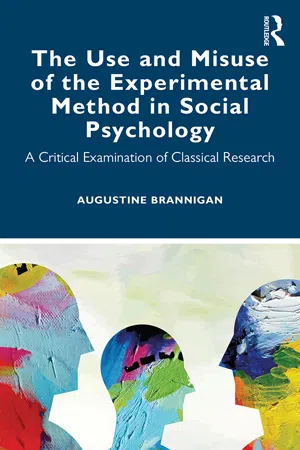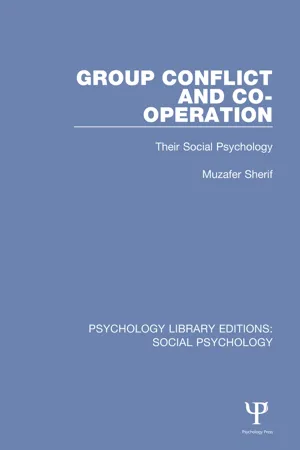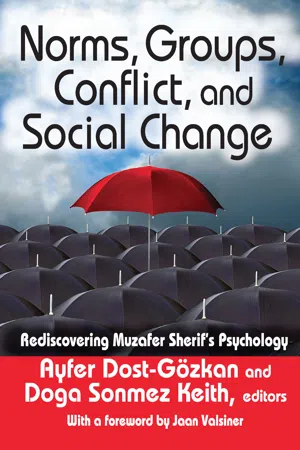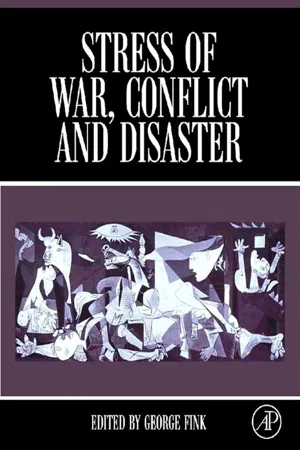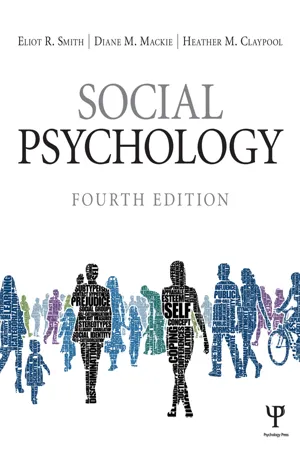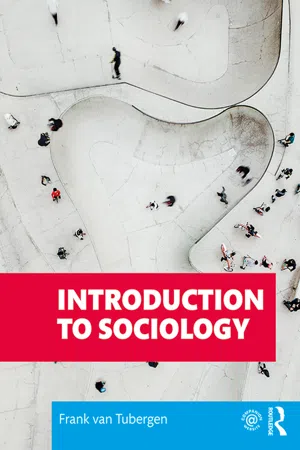Psychology
The Robbers Cave Experiment
The Robbers Cave Experiment was a classic study in social psychology conducted by Muzafer Sherif and colleagues in 1954. The study involved creating conflict and cooperation between two groups of boys at a summer camp, revealing the formation and escalation of intergroup hostility. This experiment demonstrated the impact of group dynamics and the potential for conflict resolution through cooperative activities.
Written by Perlego with AI-assistance
Related key terms
11 Key excerpts on "The Robbers Cave Experiment"
- eBook - ePub
Psychoanalysis, Classic Social Psychology and Moral Living
Let the Conversation Begin
- Paul Marcus(Author)
- 2019(Publication Date)
- Routledge(Publisher)
4 INTERGROUP CONFLICT VERSUS COOPERATION Sherif’s Robbers Cave experiment (1954) “Civilized society,” said Freud in Civilization and its Discontents, “is perpetually menaced with disintegration through this primary hostility of men towards one another” (1961, p. 112). In the last paragraph of his essay, Freud observed, “Men have gained control over the forces of nature to such an extent that with their help they would have no difficulty in exterminating one another to the last man” (ibid., p. 145). Indeed, Freud’s troubling words written in 1930 are incredibly timely. As of 2011, there were 37 armed conflicts throughout the world (Themner & Wallensteen, 2012), and there are currently about 25 armed conflicts and nuclear threats from North Korea and Iran that have serious bearing on American foreign policy and world stability. 1 Taken together, wars and genocides have led to about 200 million deaths in the twentieth century (Bohm et al., in press, p. 1). It is within this ominous context that the pioneering intergroup relations and conflict studies of Muzafer Sherif and his colleagues (henceforth, Sherif) from the early 1950s 2 should be appreciated (Sherif et al., 1988). For as the late Harvard social psychologist Roger Brown noted, the Robbers Cave study, the most famous of the Boys’ Camp studies, as they are collectively known 3, was “the most successful field experiment ever conducted on intergroup conflict” (Platow & Hunter, 2017, p. 147). 4 What makes Sherif’s experiments so important is that they demonstrate to what extent real-life group behavior is context-dependent and setting-specific, compared to individual dispositional/personality factors, biological considerations or ingroup dynamics (ibid., p. 146). Specifically, Sherif demonstrated that intergroup conflict and hostility surfaces when there is competition for limited resources, prompting group members to think and behave negatively toward the other group. Conversely, as Carolyn W - eBook - ePub
Social Psychology
How Other People Influence Our Thoughts and Actions [2 volumes]
- Randal W. Summers, Randal W. Summers, Randal W. Summers(Authors)
- 2016(Publication Date)
- Greenwood(Publisher)
There were actually a series of three experiments, begun in Connecticut in 1954 and concluded in Oklahoma in 1961. Twenty-two 11- to 12-year-old boys were taken to a summer camp in Robbers Cave State Park, Oklahoma. The boys were from middle-class families and were carefully screened and found to be psychologically normal. The boys were not aware that they were subjects in an experiment. The researchers randomly divided the boys into two groups before they arrived at the camp. The purpose was to create social groups that eventually came into conflict with each other. To administer the experiment procedures, the researchers played the role of camp counselors. The experiments had three phases: (1) group formation, 2) group conflict, and (3) conflict resolution. In phase one, each group settled in a different area of the camp and initially were not aware of the other group. Members within a group got to know each other, social norms developed, and leadership and structure emerged. In phase two (group conflict) groups came into contact with each other. They competed in games, challenges, and also competed for control of territory. A lot of animosity and low-level violence occurred between the groups. In phase three (conflict resolution), the experimenters tried various ways to bring peace and cooperation between the two groups by increasing communication and contact between them and introducing superordinate goals for the groups.The results of Sherif’s Robbers Cave experiments indicated not only how prejudice and conflict build up between groups but also how integration and socialization through the introduction of superordinate goals were effective in reducing conflict. Superordinate goals were large goals that required both groups working together to achieve. Subsequent to this experiment, studies confirmed that intergroup socialization is the most effective way to reduce prejudice and discrimination.Further ReadingMcLeod, S. “Robbers Cave.” Simply Psychology, 2008. Retrieved from www.simplypsychology.org/robbers-cave.html .Muzafer Sherif, et al., Intergroup conflict and cooperation: The Robbers Cave Experiment (Oklahoma: University of Oklahoma Press, 1961). Reprint edition, (Wesleyan University Press, 1988).Sherif, M., O. J. Harvey, B. Jack White, William R. Hood, and Carolyn W. Sherif. “Intergroup conflict and cooperation: The Robbers Cave Experiment.” Classics in the History of Psychology, 1954/1961. Retrieved from http://psychclassics.yorku.ca/Sherif .1958—Harlow’s “Wire/Cloth” Monkey Experiments, Harry HarlowHarry Harlow (born Harry Israel in 1905) obtained his PhD from Stanford University and then became a faculty member at the University of Wisconsin in 1930. His famous research into the social behavior of monkeys resulted in significant impact on the areas of affection, motivation, and learning. His findings in the field of comparative psychology on the need for “contact” have been generalized to the study of child psychology. - eBook - ePub
Social Identifications
A Social Psychology of Intergroup Relations and Group Processes
- Dominic Abrams, Michael A. Hogg(Authors)
- 2006(Publication Date)
- Routledge(Publisher)
The next stage was designed to see what would happen when the two groups came into contact, particularly when this contact involved competition for a prize. The two groups were pitted against one another in an organized tournament involving a variety of games such as baseball and a treasure hunt. The initial spirit of goodwill disappeared as the tournament progressed. The boys began to taunt and jeer at members of the other group, denouncing them as ‘snakes’ and ‘stinkers’. By the end of the tournament the two groups virtually refused to talk to each other and began to launch secret raids and attacks on each other’s cabin. In the Robbers Cave study the groups took part in a game where each had to collect as many (scattered) beans as possible in a set time. The beans supposedly collected by each person were displayed briefly on a screen, and the boys had to estimate how many there were. Although only thirty-five beans were actually shown each time, the boys overestimated the number collected by ingroup members and underestimated the number retrieved by outgroup members (cf. Blake and Mouton 1962). This stage demonstrated that, as a result of intergroup competition, an apparently amiable and well-adjusted collection of boys had been transformed. They now appeared ‘wicked, disturbed, and vicious’ (Sherif 1966:85).The conclusions to be drawn from this third stage in the studies (the 1953 study had to be terminated due to the extremity of intergroup antipathy!) were as follows. First, cultural, physical, and personality differences are not necessary for (and hence cannot be the only causes of) the emergence of intergroup conflict. Second, the existence of two groups in competition for a goal which only one can attain (competitively interdependent) is a sufficient condition for (and hence can be the sole cause of) intergroup hostility.The final stage of The Robbers Cave Experiment was designed to repair the relations between the groups and reduce intergroup conflict. One attempt to achieve this involved giving lectures on brotherly love and forgiveness at the Sunday services. Despite enjoying the services as a whole the boys seemed to have completely ignored the peaceful messages, and rapidly reverted to their preoccupation with beating or avoiding the outgroup. In the 1949 study, one successful means of ameliorating tensions between the two groups had been the introduction of a common enemy (a third competing group). However, as Sherif notes, this solution was undesirable since it simply meant a widening of intergroup conflict to a larger scale, ‘and would not lead to a lasting change in attitudes between the two original groups (Sherif 1966).At Robbers Cave two other methods were employed to create more friendly intergroup relations. First, the two groups were brought into equal status contact . As Williams (1947) and then Gordon Allport (1954) had argued, direct interpersonal contact between members of equal-status groups should lead to a reduction in intergroup prejudice as a result of the development of rewarding interpersonal relationships between members of the two groups (see Ch. 4 below; Miller and Brewer 1984; Hewstone and Brown 1986, for a recent overview of this hypothesis). However, Sherif hypothesized that contact would not be sufficient to reduce conflict. An additional requirement would be that the groups must meet, ‘under conditions embodying goals that are compelling for the groups involved, but cannot be achieved by a single group through its own efforts and resources’ (Sherif 1966:88). Such goals are termed superordinate goals - eBook - ePub
Uncivil Agreement
How Politics Became Our Identity
- Lilliana Mason(Author)
- 2018(Publication Date)
- University of Chicago Press(Publisher)
cheaters, and they began to show reluctance to spend time with members of the other team. Even boys who were compelled to sit out the competitions hurled insults from the sidelines.In the next few days, the relations between the teams quickly degraded. The Eagles burned the Rattlers’ flag. The Rattlers raided the Eagles’ cabin in the middle of the night. The Eagles raided the Rattlers’ cabin in the middle of the day. Boys from both sides began to collect rocks to use in combat, fistfights broke out, and the staff decided to “stop the interaction altogether to avoid possible injury” (Sherif et al. 1988, 115). They were sent back to their separate camps. By the end of the second week, twenty-two highly similar boys who had met only two weeks before had formed two nearly warring tribes, with only the gentle nudge of isolation and competition to encourage them.By the start of the third week, the conflict had affected the boys’ abilities to judge objective reality. They were given a task to collect as many beans off the ground as possible. Each boy’s collection was viewed by both groups on an overhead projector for five seconds. The campers were asked to quickly estimate the number of beans collected by each child. Every boy estimated more beans for their own teammates than for the children on the opposing team. The experimenters had shown them the same number of beans every time.The Robbers Cave Experiment was one of the first to look at the determinants and effects of group membership and intergroup conflict. It inspired years of increasingly precise and wide-ranging research, looking into exactly how our group memberships shape us, affect our relationships with outsiders, and distort our perceptions of objective reality. The following chapters will discuss many of these results. But the simplicity of The Robbers Cave Experiment is itself telling. The boys at Robbers Cave needed nothing but isolation and competition to almost instantaneously consider the other team to be “dirty bums,” to hold negative stereotypes about them, to avoid social contact with them, and to overestimate their own group’s abilities. In very basic ways, group identification and conflict change the way we think and feel about ourselves and our opponents. - eBook - ePub
The Use and Misuse of the Experimental Method in Social Psychology
A Critical Examination of Classical Research
- Augustine Brannigan(Author)
- 2020(Publication Date)
- Routledge(Publisher)
post hoc nature of his reasoning is never openly discussed, and the theatrical or dramatic structure of the experiment was similarly relegated to history. From this perspective, the suspicion that the subjects experienced no genuine shifts in perception resulting from group influence would be immaterial, since the process was already a matter of earlier scientific recognition. Some introspective accounts from the 1937 report suggest that certain individuals knew they were being influenced by others, although others apparently were influenced and either did not realize it or would not acknowledge it. After immigrating to the US in 1945, Sherif’s work became far more concrete. His abstract laboratory experiments were succeeded by long-term field experiments.Sherif, group conflict and the summer camp field studies: an archival exposé of Sherif’s field experiments
After the autokinetic effect, Sherif’s most famous work involved a summer camp experiment at Robbers Cave State Park in 1954 (Sherif, White, and Harvey 1955; Sherif 1956). This was actually his third field experiment. In 1949, he recruited twenty-four adolescent boys from New Haven, Connecticut. They were from under-privileged backgrounds and were invited for a “free” camp with the proviso that parents were barred from visiting the boys – to prevent “distraction”. The parents and the boys were told that “new methods of camping were being tried out” (Perry 2018:29). The camp was held at Happy Valley in the Litchfield Hills in Connecticut. No one was informed that the conditions were being manipulated by psychologists to observe the group dynamics. After several days of normal camp activities where the boys socialized freely, they were divided into two groups – the Red Devils and the Bull Dogs. They were encouraged to bond in their new groups and the two groups were subsequently induced to compete for valuable trophies. This was done to illustrate Sherif’s views of the origins of intense conflicts observed throughout the 20th century. These arose, not from the properties of individuals, but from competition between groups for scarce resources. In Sherif’s view, it was possible to take well-adjusted individuals, to place them into arbitrary groups competing for scarce resources and, as a consequence, to produce intense hostility between them. The prizes were expensive, stainless steel jack-knives, and were highly coveted by the boys. After several days of competition, the winners were announced, and fighting broke out between the two groups. According to Sherif, on the last day at lunch, the two groups were “lined up on opposite sides of the mess hall calling names and finally throwing food, cups, table knives” at each other (quoted in Perry 2018:14). - eBook - ePub
Group Conflict and Co-operation
Their Social Psychology
- Muzafer Sherif(Author)
- 2015(Publication Date)
- Psychology Press(Publisher)
et al., 1961). A composite picture of the conduct and findings of the three studies will be presented here, with specification of the source when this is feasible without confusing the account. The first experiment, conducted in 1949 in Connecticut, was carried through the stage of intergroup conflict. All the hypotheses presented here were formulated before the second study, but the systematic sequence of stages in that study had to be terminated after the rise of intergroup hostility. The third experiment, conducted at Robbers Cave, Oklahoma, was carried through the sequence of group formation, intergroup conflict, and reduction of intergroup conflict which was contingent upon cooperative activities between erstwhile hostile groups.Choice of Subjects
Because the experiments were performed at camp sites, subjects were selected who would find camping a natural and fascinating activity: boys between eleven and twelve years old. In order to eliminate, as much as possible, alternative explanations for events that transpired in the experiments, the selection procedures were long and careful. Interviews were held with each boy's teachers, school officials, and family. School and medical records were studied, and scores were obtained on psychological tests. Each boy was observed in natural give-and-take with agemates in the classroom and during athletic and informal interpersonal activities.As a result of the methods of selecting subjects, the results could not be explained in any of the following alternative ways: 1. Previous acquaintance or personal ties among the boys. Boys were chosen from different schools and neighborhoods to eliminate this possibility.2. Neurotic tendencies, undue instability, or excessively frustrating situations in past history. The boys were healthy, well adjusted in school and neighborhood, members of stable families with both parents living at home (no broken homes), and with no record of past disturbances in behavior. Members of minority groups who might have suffered from social discrimination were not included. - eBook - ePub
- Jane Callaghan, Lisa Lazard(Authors)
- 2011(Publication Date)
- Learning Matters(Publisher)
In the first instance, they tried simple contact-based activities such as getting together for fireworks or to watch a film. This produced no real reduction in intergroup hostilities (one attempt at reconciliation ended with a food fight. . .). Once simple contact had failed, the research team introduced co-operative activities focused on a unifying superordinate goal. For example, boys were told that vandals had damaged the water system that supplied the camp with water from the local reservoir. The boys went out to try to resolve this problem and found a full tank of water with a tap that had been blocked with a sack. If the boys wanted to drink or use the toilets, they would have to fix the problem. Faced with a problem that threatened both groups of boys, they began to work co-operatively to solve the problem, suggesting and trying out solutions together. When the water came through, the boys celebrated together and were gracious in the distribution of water. Several co-operative tasks of this sort were introduced as part of camp life, and functioned to reduce intergroup hostility. Sherif and his colleagues suggested that the reduction of hostility was a result of joint activity in pursuit of superordinate goals as well as the joint celebration of achievement. On the final day, most of the boys agreed that they would prefer to share the bus home, and boys did not sit in their in-groups on the bus on the way home. So what does The Robbers Cave Experiment tell us about intergroup prejudice and racism? Dixon and Durrheim (2003) suggest that conflict and threat often precede racial intolerance. When groups are perceived as having different goals, or goals that clash with each other, and are competing for resources such as housing, jobs etc., intergroup conflict is often an outcome. While this kind of threat perception can produce conflict between groups without interference in the modern world, we often see this manipulated by interest groups - eBook - ePub
Norms, Groups, Conflict, and Social Change
Rediscovering Muzafer Sherif's Psychology
- Ayfer Dost-Gozkan(Author)
- 2017(Publication Date)
- Routledge(Publisher)
It is certainly the case that a proper reading of the field of social psychology necessarily includes the works of Sherif and his colleagues. And, we venture a guess, if any reading is to be had, it will be of the field-study examining intergroup relations conducted at Robbers Cave State Park in Oklahoma. There are good reasons for this: the procedures were engrossing and the findings were intriguing. As a result, the study is able both to inspire thousands of first-year psychology students every year, and to capture the imagination of the wider public. Our suspicion, however, is that the vividness of this field study, coupled with its apocryphal dissent into some form of tribal collective unconscious, is what impresses (if not impassions) imaginations. We must remind ourselves, then, that in sharp contrast to the popularized fiction with which these field studies are often compared, Sherif’s science revealed fundamentally the interdependent nature of collective life and individual psychologies. Sherif was not, say, William Golding, and Sherif’s participants did not become savages—there was, of course, no tribal dissent. As we have noted elsewhere (Platow &Hunter, 2014), good fiction should not be conflated with good science.Equally as important as not conflating Sherif’s science with fiction, however, is not letting the Robbers Cave study blind us to the larger body of his work. Indeed, and in clear contradistinction from much of the popular fiction, Sherif’s earliest social-psychological work—his PhD thesis, in fact—demonstrated the establishment, rather than degeneration, of group norms (Sherif, 1935). Again, it is a rare first-year psychology student who does not know of the famous autokinetic-ef-fect studies of norm formation. These studies persuasively showed the manner in which people develop a consensual understanding of the physical reality confronting them. Despite initial idiosyncratic and, hence, varied understandings of an identical reality, group interaction bound observers together through a shared - eBook - ePub
- George Fink(Author)
- 2010(Publication Date)
- Academic Press(Publisher)
Sometimes two approaches are combined. The PD paradigm coupled with Richardson’s formal mathematical model of the arms race led to a creative proposal by Charles Osgood to de-escalate a conflict environment and obtain peace in the absence of ideological agreement. Pilisuk and Skolnick then investigated Osgood’s propositions through a formal game.Quantitative political science frequently reverses the dominant investigative process just described. The data are the events themselves as recorded in history. The patterns of cooperation and conflict among political states, including the escalation and de-escalation of wars and rivalries, are then evaluated based on the historical facts. Both psychological and structural concepts are employed, including grievances, power of the disputants, regime type, threat, and transitions in culture and political organization.Political scientists are more likely than psychologists to test psychological explanations of intergroup conflict against the actual events. The relationship of frustration, relative deprivation, and justice to group conflict, and the effects of stress on the decision-making process are examples.Finally, the anthropological–historical investigations are predominantly structurally oriented with emphasis on environmental circumstances, social organization, and in-group interaction patterns. Their valuable contributions include the identification of societies that are relatively conflict-free. A fascinating irony is that these investigations return full circle to some of the principles derived from the Robbers Cave observations.Defining Research
Competition, Conflict, and Superordinate Goals
The robbers cave studies
During the 1950s, Muzafer Sherif conducted a series of investigations at boys camps, one of which was the Robbers Cave State Park in Oklahoma. To the participants, the experience was indistinguishable from any other 3-week summer camp even though it was staffed and engineered by social scientists. The camp session was divided into distinct stages, each lasting about a week.The boys were assigned to two groups that were brought separately to the camp. For the first few days, each did not know of the existence of the other. Strong personal ties developed along with identifying group names and emblems. Each cabin became aware of the other’s existence shortly before the second phase, the formal competitive period. The ‘tournament’ consisted of a range of contests among which were sporting events. During this competitive stage, friendship patterns were almost exclusively in-group and overt hostility emerged including fights and dormitory raids. - eBook - ePub
Social Psychology
Fourth Edition
- Eliot R. Smith, Diane M. Mackie, Heather M. Claypool(Authors)
- 2014(Publication Date)
- Psychology Press(Publisher)
The camp was more than it seemed, however. Unknown to the boys, their parents had agreed to let them participate in a field study of intergroup conflict set up by Muzafer Sherif and his colleagues—a study that came to be known as The Robbers Cave Experiment (Sherif, Harvey, White, Hood, & Sherif, 1961). The boys did not know that the camp counselors and directors were social psychologists and research assistants. Nor, at first, did members of each group know that another group was sharing the campsite.During the first week, as they took part in separate activities designed to promote group cohesion, each group developed norms and leaders. They gave themselves names, the Eagles and the Rattlers, and each group designed a flag. Toward the end of the week, the groups discovered each other. Seeing “those guys” using “our ball field” and “our hiking trails” sparked demands for a competition. The staff were only too pleased to arrange a 4-day tournament including baseball, tug-of-war, a treasure hunt, and other events. The experimenters even promised the winners a fancy trophy, shiny badges, and four-bladed pocketknives. Both groups practiced hard, cheered their teammates, and roundly booed and insulted the competition. Hostilities escalated as the tournament progressed, culminating in a flag burning when the Eagles lost the tug-of-war.The Eagles ultimately won the tournament, collecting the trophy and the coveted pocketknives. But while they were taking a celebratory swim, the Rattlers raided their cabins and stole the prizes. The rivalry had turned into full-blown war, and the staff was kept busy silencing name calling, breaking up fist fights, and cleaning up after cabin raids and food fights. The experiment had transformed 22 perfectly normal boys into two gangs of brawling troublemakers, full of hostility and intent on exacting revenge for every real or imagined slight.As you may have guessed, Sherif and his colleagues set up this situation to understand how intergroup hostilities develop and how they can be resolved. This issue is one of the most significant facing the world today: As of 2011, there were 37 armed, ongoing conflicts in various parts of the world (Themnér & Wallensteen, 2012). Unrest and hostility mar not only international relations but also interactions between ethnic, political, and religious groups. And conflict and violence occur among individuals as well as groups. Newspaper headlines scream of drive-by shootings, street crimes, spouse and child abuse, bar-room fights, even, tragically, shootings in schools by young students themselves. - eBook - ePub
- Frank van Tubergen(Author)
- 2020(Publication Date)
- Routledge(Publisher)
f ) could, in principle, result in a spiral of increasing inter-group violence—and it sometimes does, as in Hindu–Muslim violence in India and the Protestant–Catholic conflict in Northern Ireland, to name only a few cases that followed this pattern. Relatedly, research findings indicate that terrorist attacks in the name of Muslim extremists resulted in more negative views towards Muslims in several European countries (Legewie, 2013) and the 2004 Al Qaeda terrorist bombing in Madrid, which killed 191 people, resulted in a tendency of Spaniards to avoid living in close proximity to Arab immigrants (Edling, Rydgren, & Sandell, 2016).8.7 Chapter resourcesKey concepts
Group Affiliation network Civil society Organizational cohesion Intergroup cohesion Group-bonding tie Group-bridging tie Endogamy Exogamy Consolidation Foci Minimal group paradigm Social identityKey theories and propositions
- Structural opportunity theory
- Homophily theory
- Third party theory
- Social identity theory
- Group threat theory.
Key stylized facts
- Group segregation
- Homophily phenomenon
- In-group favoritism.
Summary
- Individuals belong to groups, also called affiliation networks. Group affiliation can be assigned in different ways: as membership, participation and identification.
- Groups have the capacity to generate collective benefits, such as overcoming problems of cooperation. For this reason, scholars study organizational cohesion.
Index pages curate the most relevant extracts from our library of academic textbooks. They’ve been created using an in-house natural language model (NLM), each adding context and meaning to key research topics.
